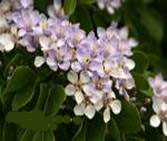| Kingdom | Plantae |
| Division | Magnoliophyta |
| Class | Magnoliopsida |
| Order | Zygophyllales |
| Family | Zygophyllaceae |
| Genus | Guaiacum |
| Species | G. officinale |
| Binomial name | Guaiacum officinale |
Other Common Names:
The other common names for the tree are Guaiac, Guayacan, Lignum Vine, Lignum vitae, Pockwood, Wood of Life and Tree of life.
History
Guaiacum officinale, also known as Pockwood is part of the Zygophyllaceae plant family. The other name Lignum vitae means "long life" in Latin, from which comes one of its common names, Tree of Life.Tree of Life is a tree yielding the true lignum vitae, a wood once used to treat syphilis. Lignum Vitae are the heaviest and densest wood in the world and will rapidly sink to the bottom when placed in water.

Description
This tree grows very slowly, varying in height from 15 to 50 feet. The trunk is usually crooked, with crowded, knobby, short-jointed, flexuose, spreading branches, about 4 feet in diameter; the bark is furrowed, spotted, and greyish. The leaves are opposite, bijugate or trijugate; the leaflets sessile, more or less obovate, rounded at the apex, nerved, and glabrous; the common petiole is terete and channeled above. The flowers are light-blue, on axillary peduncles, which are an inch long, 1-flowered, filiform, minutely downy, and several together.


Range
The tree is native to the West Indies, southern Florida, the western coast of Central America, and the northern coast of South America and as well as extreme southern Florida.
Habitat
Lignum vitae grow successfully in a wide range of soil types and once established, are drought and salt tolerant. Regular irrigation and fertilizing will enhance growth in this plant, reputed to be a slow grower. Although it flowers best in full sun, it can flourish in partial shade. Little pruning is required to keep it shapely.
Cultivation
Lignum vitae are easily propagated from seed. Due to recalcitrant nature of the seeds, they have a short viable life, can not be dried well and can not withstand low temperatures. Thus for cultivation they need full sun and has to be protected from low temperature. Today many of these trees are doing well, but are growing slowly. Even under optimum natural conditions seedlings tend to grow slowly. In cultivation however, with constant watering and fertilizing, seedlings grow a little faster. One seedling is known to have grown three feet in canopy diameter in two years.
Blooming Period
When the tree blooms, usually in the late spring or early summer, it produces small blue flowers, which later develop into bright orange fruits.
Pests and Diseases
Generally theses species are very rarely said to be affected by pests and diseases.
Parts Used

The wood, bark and the resin are the most commonly used parts of the tree for its commercial and medicinal purposes.
Medicinal Applications


• The resins of the lignum vitae are effective anti inflammatory agents and have been used to treat arthritis, gout, and sciatica.
• It is used in relieving the symptoms of fish poisoning and a tea made from the flowers and leaves is reputed to be an excellent energy restorative.
• The wood was originally taken to Europe as a much-needed cure for gout and syphilis.
• It is used as an antioxidant in packaged and canned foods.
• The decoction of the wood was administered in gout, the stone, palsy, leprosy, dropsy, epilepsy, and other diseases.
• They are also used in pharmaceutical preparations for sore throats and for inflammatory diseases such as rheumatoid arthritis and gout.
• Resin is applied to the tooth for a toothache, and applied externally for rheumatism.
• For gout, blood pressure and arteriosclerosis resin is taken orally.
Commercial Applications


• Lignum vitae wood was used in the past to make ball bearings because its extremely high resin content makes it self-lubricating.
• Lignum vitae were used was in United States courtrooms, where the judge's gavel was traditionally made from this fine wood.
• Lignum vitae are a great medium for carvings.
• Lignum vitae may be used together with bog bean, meadowsweet or celery seed.
• They are used to make bearings used in the propellant shafts.

In back time Virgin Islands when someone's problems were especially severe or when someone was carrying an extremely heavy emotional burden it was said that their troubles were "heavier than a Lingy Vitae cross. Before the European colonization, which led to the deforestation of St. John, there were many stands of Lignum vitae on the island. They helped to produce a jungle-like canopy over large portions of the island, providing shade for tropical undergrowth.
It resists rot caused by insects and moisture so effectively that remains of Lignum vitae wood used as posts for dwellings by Taino Indians discovered in Tutu, St. Thomas were dated by carbon dating and found to be over 800 years old.profession of Europe as a specific for many of the most serious diseases of mankind. The name lignum-vitae (wood of life) originated from the supposition that the material was possessed of extraordinary remedial powers. So great was the demand that for a time the wood was sold for as much as 7 gold crowns a pound. Numerous learned treatises were published and served to establish the reputation of the wood so firmly that it was nearly 200 years before it was seriously questioned.